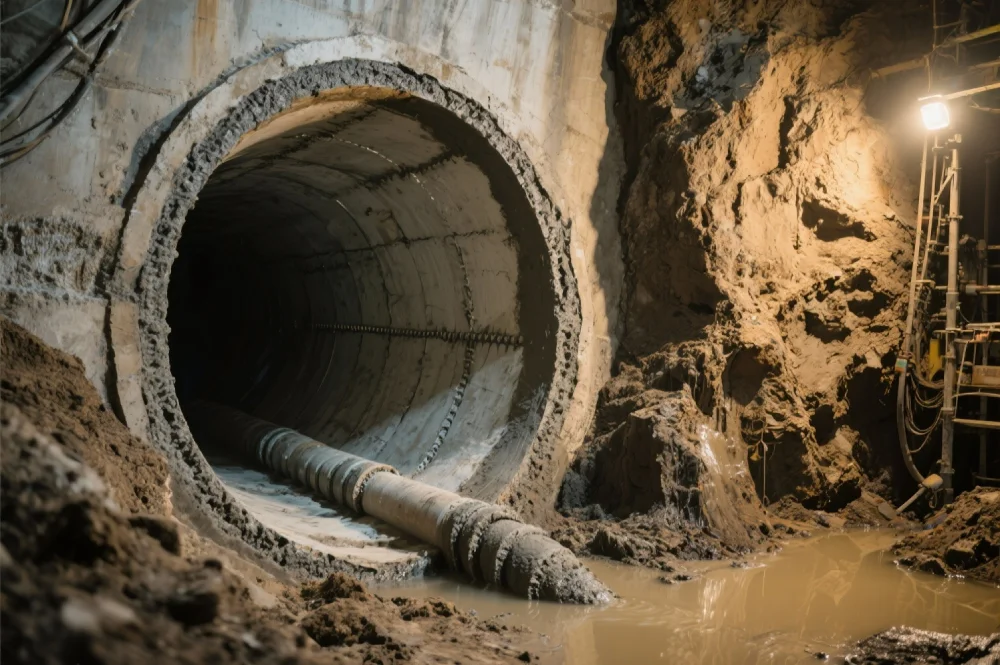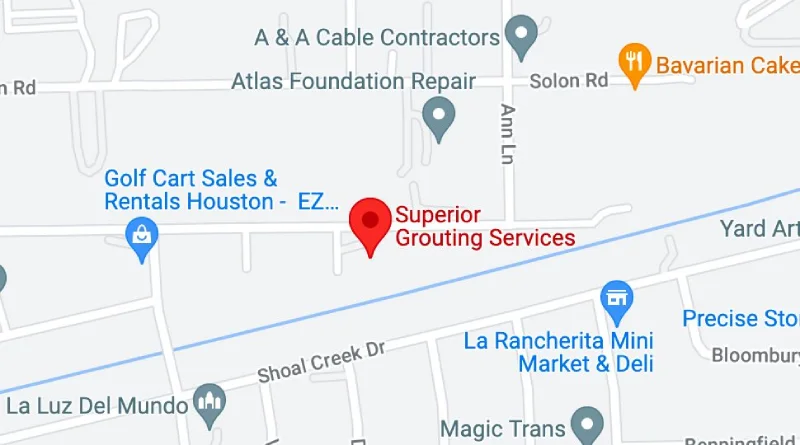How Annular Grouting Prevents Washouts Around Shafts

Annular grouting fills the void between shaft casings and surrounding soil with pressurized grout, creating a waterproof seal that stops groundwater infiltration and prevents soil erosion around critical infrastructure.
Washouts around shafts pose a serious threat to infrastructure stability. When water seeps into the annular space (the gap between a shaft casing and the surrounding ground), it can carry away soil particles, creating voids that lead to settlement, sinkholes, and structural failure.
Annular grouting solves this problem by filling these gaps with specialized grout materials under controlled pressure. This process creates a permanent seal that protects shafts used in tunnels, utilities, and underground structures from water-driven soil loss. For projects involving levees, water treatment facilities, and critical infrastructure, professional grouting services ensure long-term stability and safety.
Key Takeaways
- Annular grouting fills the void between shaft casings and surrounding soil, creating a waterproof barrier that prevents groundwater infiltration and stops soil particles from washing away around critical infrastructure installations.
- The process uses specialized materials including cement-based slurries, polyurethane gels, and cellular concrete, each selected based on specific soil conditions, water presence, and structural requirements of the project.
- Pressure-controlled injection with real-time monitoring ensures complete filling of annular spaces while preventing soil damage, with technicians tracking injection pressure, flow rate, volume, and temperature throughout the operation.
- Professional annular grouting restores bearing capacity around shafts by replacing lost soil volume, providing lateral support, and creating a stable zone that prevents settlement, tilting, and progressive failure.
- Applications include tunnel construction, utility shaft protection, and water infrastructure projects where geotechnical stability and long-term performance are critical to public safety and operational reliability.
- Successful projects require experienced contractors with specialized equipment, technical expertise in subsurface conditions, and comprehensive quality assurance including verification testing and detailed documentation of grouting operations.
What Is Annular Grouting and Why Does It Matter?
Annular grouting is a specialized technique that fills the space between an installed shaft casing or tunnel lining and the native soil or rock formation.
The Annular Space Problem
The annular space creates a pathway for problems:
- Water infiltration: Groundwater flows through the gap
- Soil migration: Fine particles wash away with water movement
- Void formation: Empty spaces develop as soil erodes
- Structural instability: Loss of bearing capacity around the shaft
- Surface settlement: Ground above the shaft sinks or collapses
How Grouting Stops Washouts
The grouting process addresses each problem by sealing the annular space completely and blocking groundwater pathways. The injected grout locks soil particles in place, restores ground density and strength, and prevents future erosion and migration.
This protection is critical for shafts supporting utilities, tunnels, and other underground infrastructure where failure could disrupt operations or endanger public safety.
The Annular Grouting Process
The process follows a systematic approach designed to achieve complete filling and long-term performance. Proper execution requires technical expertise and specialized equipment to ensure the grout reaches all voids and creates a durable seal.
Site Assessment and Preparation
Before grouting begins, engineers evaluate subsurface conditions:
- Soil type and stability
- Groundwater levels and flow patterns
- Shaft dimensions and casing specifications
- Existing void sizes and locations
- Access points for grout injection
This assessment determines the grout material, injection pressure, and monitoring approach needed for success.
Material Selection
Grout selection depends on site conditions, performance requirements, and project specifications. The table below compares common grout types used in annular grouting:
| Grout Type | Best Applications | Key Benefits | Typical Set Time |
| Cement-Based Slurry | Stable soils, large voids, permanent structures | High strength, cost-effective, proven durability | 4-24 hours |
| Polyurethane Gel | Active water infiltration, fine soils, urgent repairs | Rapid set, expands to fill gaps, water-reactive | 15-60 seconds |
| Cellular Concrete | Low-density fill, weight-sensitive areas, large volumes | Lightweight, flowable, controlled density | 12-48 hours |
Each material serves specific conditions. Cement-based slurries provide maximum strength for permanent installations. Polyurethane works well when active water flow requires immediate sealing. Cellular concrete offers controlled density for applications where weight matters.
Pressure-Controlled Injection
Grout injection happens through ports installed at strategic locations around the shaft. Technicians pump grout under controlled pressure, monitoring several factors:
- Injection pressure: Keeps grout flowing without damaging surrounding soil
- Flow rate: Ensures complete filling without creating new pathways
- Volume tracking: Confirms grout reaches all intended areas
- Temperature: Affects set time and material performance
Advanced monitoring systems track these variables in real time, allowing adjustments during injection to achieve optimal results.
Quality Verification
After injection, verification confirms the grout sealed all voids:
- Visual inspection of grout returns at surface ports
- Pressure testing to confirm seal integrity
- Ground penetrating radar or sonic testing to detect remaining voids
- Core sampling in critical applications
This verification ensures the annular space is completely filled and the washout risk is eliminated.
How Annular Grouting Protects Against Specific Washout Risks
Understanding how grouting addresses different washout mechanisms helps clarify why this technique is so effective for shaft protection.
Groundwater Infiltration Control
Groundwater is the primary driver of washouts. When water enters the annular space, it creates hydraulic pressure that loosens soil and carries particles away. The grout barrier stops this process by:
- Creating a continuous waterproof seal around the entire shaft perimeter
- Eliminating flow paths that allow water movement
- Resisting hydrostatic pressure from surrounding groundwater
- Maintaining seal integrity even as groundwater levels fluctuate
For projects in high-water environments like water treatment facilities or structures near rivers, this waterproofing function is critical to long-term stability.
Soil Particle Stabilization
Fine soil particles are vulnerable to migration when water flows through the annular space. This migration creates progressively larger voids that can extend far beyond the immediate shaft area. Annular grouting prevents this chain reaction:
- The grout penetrates into surrounding soil, binding particles together
- Chemical bonds between grout and soil create a stable mass
- The hardened grout matrix locks particles in their original positions
- No pathways remain for water to carry particles away
This stabilization extends beyond just filling the annular gap. It creates a zone of improved ground around the shaft that resists future washout even under challenging conditions.
Bearing Capacity Restoration
Washouts reduce the ground's ability to support loads. As soil washes away, the shaft loses the surrounding support it was designed to have. This loss can lead to:
- Shaft settlement or tilting
- Cracking in connected structures
- Overstressing of the shaft itself
- Progressive failure that spreads to adjacent areas
Annular grouting restores bearing capacity by replacing lost soil volume with a stable, load-bearing material. The grout provides lateral support to the shaft and transfers loads to competent soil or rock beyond the affected zone.
Applications Where Annular Grouting Prevents Washouts
Different infrastructure types face unique washout challenges that annular grouting addresses effectively.
Tunnel and Shaft Construction
During tunnel boring and shaft installation, the excavation often creates a larger opening than the final lining requires. This overcut leaves an annular space that must be filled to prevent:
- Settlement of surface structures above the tunnel
- Water ingress that could flood the tunnel
- Long-term soil consolidation around the lining
- Damage to adjacent utilities or foundations
Grouting immediately after lining installation protects the tunnel and surrounding infrastructure from these risks.
Utility Shaft Protection
Utility shafts for water, sewer, electrical, and communication systems require long-term stability. These shafts often pass through varied soil layers with different erosion potential. Common risks include:
- Differential settlement between soil layers
- Preferential water flow along the shaft exterior
- Soil shrinkage during dry periods creating gaps
- Vibration from traffic or operations loosening soil contact
Proper annular grouting eliminates these pathways and maintains consistent support around the entire shaft depth.
Water Infrastructure Projects
Shafts associated with dams, levees, and water treatment facilities face constant water exposure. The combination of high water pressure and long service life requirements makes washout prevention critical. Grouting provides:
- Permanent waterproofing that lasts decades
- Resistance to water chemistry and temperature changes
- Protection against seasonal water level fluctuations
- Peace of mind for structures protecting public safety
These high-stakes applications demand the reliability and durability that professional pressure grouting services deliver.
Advantages of Professional Annular Grouting Services
Successful annular grouting requires more than just pumping grout into a hole. Professional execution makes the difference between a lasting solution and a temporary fix.
Technical Expertise
Experienced grouting contractors understand:
- How different soil types respond to grout injection
- Which materials work best for specific conditions
- How to adjust injection parameters during the process
- When additional measures are needed for challenging sites
This expertise prevents common problems like incomplete filling, excessive pressure that damages soil, or material selection that fails to meet performance requirements.
Specialized Equipment
Professional grouting operations use purpose-built systems that ensure quality:
- High-pressure pumps with precise flow control
- Mixing equipment that produces consistent grout properties
- Monitoring instruments that track multiple parameters simultaneously
- Backup systems that prevent interruptions during critical injection phases
This equipment level is beyond what most general contractors can access, making specialized grouting services the practical choice for important projects.
Quality Assurance and Documentation
Professional services include comprehensive documentation:
- Pre-grouting site conditions and void surveys
- Injection records showing pressures, volumes, and times
- Material certifications and mix design data
- Post-grouting verification test results
- As-built drawings showing grouted areas
This documentation proves the work was done correctly and provides a reference for future maintenance or adjacent construction.
Long-Term Performance Guarantees
Reputable grouting contractors stand behind their work with warranties that cover:
- Material performance over specified time periods
- Structural integrity of the grouted zone
- Waterproofing effectiveness
- Response to any performance issues that arise
These guarantees provide project owners with confidence that their investment will deliver lasting protection.
Monitoring and Maintenance After Annular Grouting
While annular grouting creates a durable solution, proper monitoring ensures continued performance and identifies any issues before they become serious.
Initial Monitoring Period
The first months after grouting are critical for confirming success:
- Survey points track any ground movement or settlement
- Observation wells monitor groundwater levels and clarity
- Visual inspections check for surface signs of water or void development
- Instrumentation measures shaft stability and stress levels
Any deviations from expected performance trigger investigation and corrective action if needed.
Long-Term Performance Tracking
Over years and decades, periodic checks confirm the grouted zone maintains its integrity:
- Annual visual inspections of accessible areas
- Review of any nearby construction or ground changes
- Comparison of current conditions to baseline data
- Assessment of whether changing site conditions require additional protection
This ongoing attention catches potential problems early when they are easiest and least expensive to address.
When Additional Grouting May Be Needed
In some cases, additional grouting becomes necessary years after the original work:
- New construction nearby that changes groundwater patterns
- Seismic activity that creates new pathways
- Deterioration of grout in aggressive soil or water chemistry
- Expansion of facilities that affects loads on the shaft
The table below shows signs that indicate additional grouting may be needed:
| Warning Sign | What It Means | Recommended Action |
| New surface settlement near shaft | Possible void development below | Immediate void investigation and grouting |
| Water seeping at ground surface | Seal failure or new water pathway | Pressure testing and seal repair |
| Shaft movement or tilting | Loss of lateral support | Structural assessment and support grouting |
| Increased groundwater turbidity | Soil particle migration | Water monitoring and preventive grouting |
Early detection and response prevent minor issues from becoming major problems that threaten shaft stability and safety.
Choosing the Right Grouting Contractor
The contractor you select determines whether your annular grouting project succeeds or fails. Several factors separate qualified specialists from general contractors who occasionally do grouting work.
Experience With Similar Projects
Look for contractors who have completed projects like yours:
- Similar shaft sizes and depths
- Comparable soil and groundwater conditions
- Experience with your specific infrastructure type
- Work for similar clients (municipal, state, federal agencies)
This experience means they understand the challenges your project presents and know how to handle unexpected conditions that may arise.
Technical Capabilities
Verify the contractor has the right technical foundation:
- Licensed engineers who can design grouting programs
- Certified technicians who operate equipment properly
- Quality control systems that ensure consistency
- Testing capabilities to verify results
These capabilities distinguish professional grouting specialists from contractors who just have pumps and hoses.
Project References and Track Record
Ask for references from recent projects:
- Contact information for project managers or owners
- Documentation of successful completion
- Examples of how they handled challenges
- Long-term performance data if available
Quality contractors welcome these inquiries because they are confident in their work history.
Communication and Project Management
Good contractors keep you informed throughout the project:
- Clear explanations of what they will do and why
- Regular updates on progress and any changes needed
- Prompt responses to questions or concerns
- Detailed final reports with all supporting documentation
This communication ensures you understand what is happening and have confidence the work is being done right.
For infrastructure projects where washout prevention is critical to safety and performance, contact experienced grouting specialists who understand the stakes and deliver reliable results.
Conclusion
Annular grouting prevents washouts around shafts by filling the void between casings and surrounding ground with specialized grout materials. This creates a permanent waterproof seal that stops groundwater infiltration, prevents soil erosion, and maintains the structural integrity critical for tunnels, utilities, and water infrastructure.
The technique combines proper material selection, pressure-controlled injection, and comprehensive monitoring to ensure complete void filling and long-term durability. Professional execution by experienced contractors makes the difference between temporary fixes and lasting protection that performs for decades.
For projects where shaft stability matters, annular grouting delivers the reliability, safety, and peace of mind that infrastructure owners and operators require.

